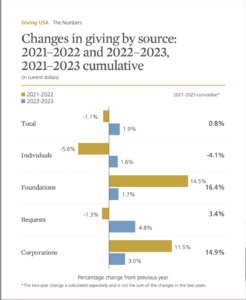Giving USA 2024: Donors Gave More, Inflation Deflated It

Giving in the United States reached a new high during 2023 – $557.16 billion – an increase of 1.9% compared to 2022. But the impact was smacked down by inflation of 4.1%, with giving by individuals, bequests, foundations and corporations showing a combined decline of 2.1% compared to 2022 in real dollar impact.
Individuals made up 67% of giving, an increase from 64% during 2022. Foundations contributed 19% of all philanthropy tracked compared to 21% during 2022. Bequests were 8%, down from 9% during 2022. Corporations inched up 1% to 7% of all giving.
Giving to religion topped the donors’ recipients list at $145.81 billion, followed by education at $87.69 billion and health at $56.58 billion. Giving made up 2% of the nation’s gross domestic product (GDP) for 2023.
The data in the annual Giving USA: The Annual Report on Philanthropy are reported in real dollars and inflation-adjusted dollars. The 2023 number of $557.16 billion will be adjusted next year but likely will not exceed the $621.29 billion of 2021.
“Fundraisers say they care about the number because we know that is what they are measured against. On the nonprofit side, if they are raising the same amount of money, that $100 is not going as far. From the donor perspective, $100 doesn’t buy as much in their own basket of goods,” said Una Osili, Ph.D., associate dean for Research and International Programs at the Lilly Family School of Philanthropy at Indiana University.
Giving has declined just five times in real numbers since 1983, the first year reported by Giving USA. However, giving has declined in inflation-adjusted numbers 35% of the time. For 2023, inflation-adjusted dollars are adjusted to 2023 dollars, so just for 2023, current and inflation-adjusted dollars are the same $557.16 billion.
“Keep in mind the economy is actually much better,” said Osili. “Most analysts had 2023 as a recessional year, not only recession and part of a pullback.” According to data from the U.S. Department of Commerce, the nation’s gross domestic product for 2023 was an estimated $27.36 trillion, which was a 6.3% increase from 2022.
“Inflation is a formidable foe. I’m glad giving is resilient in the face of it,” said Josh Birkholz, chair of Giving USA Foundation and CEO of fundraising for BWF in Minneapolis, Minnesota.
The number of deaths in the United States hit a record in 2021 at 3.46 million and 3.27 million in 2022. Time estimates for estate probate can be anywhere from six months to two years or more. The bequest number was estimated from multiple sources, according to Jonathan Bergdoll, applied statistician and associate director of Data Partnerships, at the Lilly Family School of Philanthropy at Indiana University. Much of the data is from educational institutions and reported via the Voluntary Support of Education (VSE) Survey.
“Even though we don’t have final IRS data yet 2023 … bequests tend to be what we call a little noisier because a few very large bequests can change things. There are always some spikes,” said Bergdoll. “It’s a grim truth, but we do expect, because of the great wealth transfer, for (revenue) start showing up in the bequest data in the next 10 years.”
It is getting difficult to track all giving to charity. These areas will form a foundation for giving but will need to be expanded to get a more complete picture. Osili explained there is an issue of transparency, with wealthy donors using various types of capital to infuse equity into the sector. “Perhaps as we think about the problems we are trying to solve globally, that we need more types of capital to solve these problems … one single sector with its philanthropy alone cannot tackles some of these issues,” she said.
Birkholz agrees that high net worth individuals are bringing fresh capital into the sector but might not have the intended impact.
“Already starting to see aspect of it (blended capital). The thing that is pretty universal is the need to solve big systemic problems. A ripple effect, a high-end donor would care very deeply about solving a food insecurity issue however they will rarely give to someone who needs it right now, buy someone a sandwich” said Birkholz.
He’s concerned about the decline in the total number of donors during the past decade. There needs to be more “participation participate in giving for the social value of it,” he said. “As it continues to pull upstream (to the more affluent) I’m more concerned about losing that culture value that giving is something everybody does,” he said.
His idea was echoed by Richard C. Shadyac, Jr., president & CEO of ALSAC, the fundraising and awareness organization for St. Jude in Memphis, Tennessee. “We want to make sure they can find a place in this mission whether they can be a Partner in Hope at $19 a month or make a donation of $50,000 or $100,000 or a million dollars,” said Shadyac.
“It’s not just about charitable giving. It is about charitable living, the ability to live charitably. What does that mean? They can wear our brand. They can wear our baseball cap. They can wear a t-shirt, volunteer, living a life that is charitable, being kind and doing random asks of service,” he said.
While St. Jude concentrates on where wealth congregates, such as the coasts, major cities and retirement areas, he is always surprised by the donors who were not on the radar. Two recent large donors were someone retired from U.S. Postal Services and a retired railroad conductor.

Another area is gaming. “I like to think we are the pioneer in gaming. We having been doing it for almost 10 years,” said Shadyac. Online gaming has brought in $62 million for the organization. The foundational program is Play Live, streaming of content creators “playing games and asking some of their followers to make donations to St. Jude Children’s Research Hospital,” said Shadyac. The live streams often emanate from the St. Jude campus.
St. Jude recently hosted on campus an event for 330 influencers and content creators. “It’s not just entertainment. I see these kids as having heart and real compassion,” he said.
Both Birkholz and Shadyac are frustrated that the 2% of GDP doesn’t budge much. Giving usually “usually tracked with GDP but more and more it is dominated by wealthy donors, moved to seeing the asset market predicting giving outcomes,” said Birkholz.
Said Shadyac: I always ask myself why is charitable giving 2% of GDP? Why is that acceptable? Why can’t we move the needle? It is a move to charitable living.”
Giving USA: The Annual Report on Philanthropy, the longest-running report on the sources and uses of charitable giving in America, is published by Giving USA Foundation, a public service initiative of The Giving Institute. It is researched and written by the Indiana University Lilly Family School of Philanthropy at IU Indianapolis.
The post Giving USA 2024: Donors Gave More, Inflation Deflated It appeared first on The NonProfit Times.









Leave a Reply